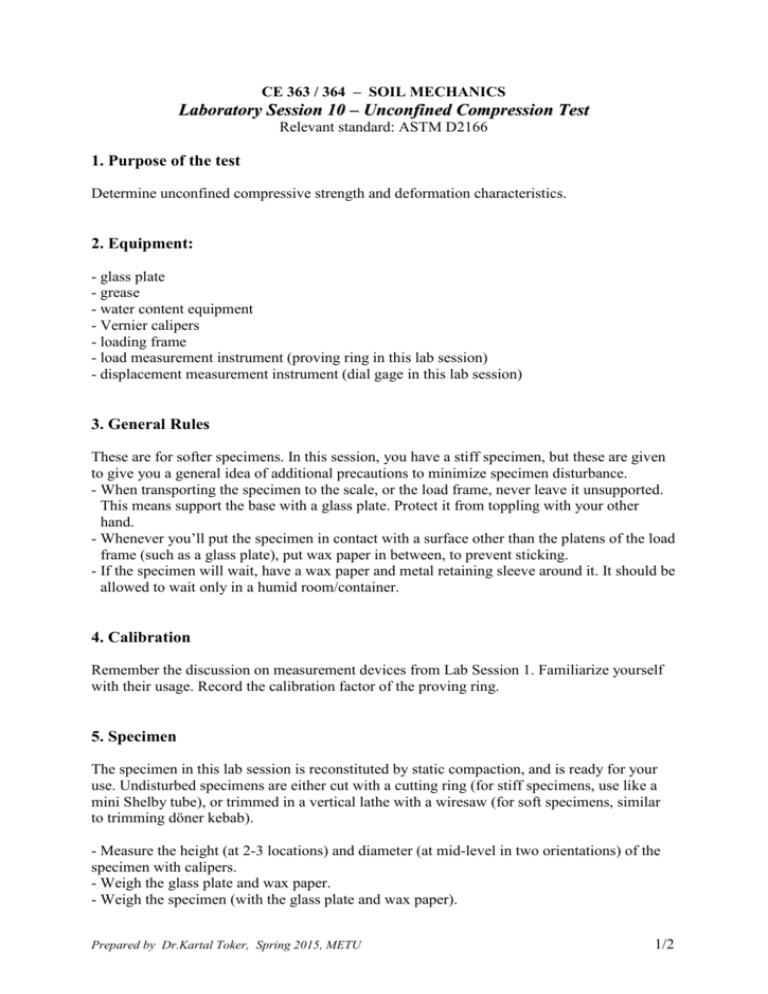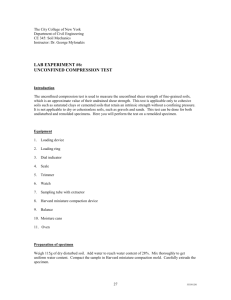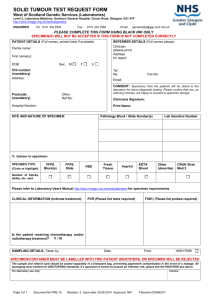CE 363 – SOIL MECHANICS
advertisement

CE 363 / 364 – SOIL MECHANICS Laboratory Session 10 – Unconfined Compression Test Relevant standard: ASTM D2166 1. Purpose of the test Determine unconfined compressive strength and deformation characteristics. 2. Equipment: - glass plate - grease - water content equipment - Vernier calipers - loading frame - load measurement instrument (proving ring in this lab session) - displacement measurement instrument (dial gage in this lab session) 3. General Rules These are for softer specimens. In this session, you have a stiff specimen, but these are given to give you a general idea of additional precautions to minimize specimen disturbance. - When transporting the specimen to the scale, or the load frame, never leave it unsupported. This means support the base with a glass plate. Protect it from toppling with your other hand. - Whenever you’ll put the specimen in contact with a surface other than the platens of the load frame (such as a glass plate), put wax paper in between, to prevent sticking. - If the specimen will wait, have a wax paper and metal retaining sleeve around it. It should be allowed to wait only in a humid room/container. 4. Calibration Remember the discussion on measurement devices from Lab Session 1. Familiarize yourself with their usage. Record the calibration factor of the proving ring. 5. Specimen The specimen in this lab session is reconstituted by static compaction, and is ready for your use. Undisturbed specimens are either cut with a cutting ring (for stiff specimens, use like a mini Shelby tube), or trimmed in a vertical lathe with a wiresaw (for soft specimens, similar to trimming döner kebab). - Measure the height (at 2-3 locations) and diameter (at mid-level in two orientations) of the specimen with calipers. - Weigh the glass plate and wax paper. - Weigh the specimen (with the glass plate and wax paper). Prepared by Dr.Kartal Toker, Spring 2015, METU 1/2 6. Procedure 123456- 7- 8910111213- Apply grease to the end platens of the load frame. Place and center the specimen on the load frame. Set/Record zero value of load measurement device. Bring the top cap to contact with the specimen. You can ensure contact by watching the load measurement. Set/record the displacement measurement device zero. Set the load frame’s displacement rate to a rate that corresponds to between 0.5 and 2 % strain per minute. Stiffer soils should be sheared slower than softer soils. In this session, 1%/min is reasonable. Start shearing. Take axial load measurements at 0.1% strain intervals upto 0.5%, then 0.2% intervals upto 1.5%, then 0.5% intervals upto 5%, and 1% intervals thereafter. Take an additional load and displacement reading when the load starts to decrease (i.e. peak load). Beware that the early readings will be quick; I recommend one person watching the displacement dial and calling out at the specified values, to another person who reads load dial at that moment. Stop when a failure plane develops, or axial load drops by 25%, or at 15% axial strain. Remove the load. Measure the diameter (2 measurements at each of top, mid- and bottom levels) of the specimen with calipers. If visible, measure the angle of failure plane from the horizontal. Draw a sketch or take a photograph of the failed specimen. Weigh the specimen. Ovendry and obtain the total dry mass of specimen. 7. Calculations - Convert axial deformations to axial strains (ax=H/Ho). - Convert axial load to stress by dividing it by the area of the specimen. However, the specimen area is enlarged during the test due to Poisson’s effect. The correct area at each axial strain can be calculated by assuming the specimen remains a cylinder and V=0 (undrained behavior), as Ao/(1-ax) - Convert peak axial stress (qu) to undrained shear strength (cu) as cu = qu/2. 8. Reporting of Results - Plot axial stress vs. axial strain. - Report unconfined compressive strength (qu) and undrained shear strength (cu). - Determine undrained tangent modulus (Eo: initial slope of graph) and undrained secant modulus (E50: slope of a line from origin to the point on the curve with =qu/2) - Discuss deformed shape in relevance to assumptions in the area correction. - Discuss orientation of failure planes if visible. - Discuss effect of water content. Prepared by Dr.Kartal Toker, Spring 2015, METU 2/2





